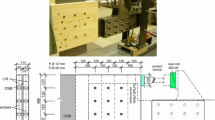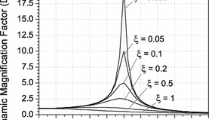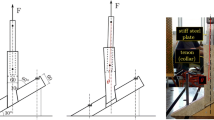Abstract
Dowel and screw connections in timber structures behave nonlinearly, even at loads which would be experienced in a structure in normal service. They exhibit hysteresis and creep as a result of both the viscoelastic behaviour of the timber itself and the frictional interaction between the timber and connecting elements, and stress concentrations are created which behave plastically, even at loads well below the nominal yield force of the connection. A fundamental process in the load transfer through such a connection is the embedment of the connector into the timber that surrounds it, and the frictional, nonlinear and time-dependent properties in that process are investigated here. A simple rheological model, a combination of Kelvin–Voigt viscoelastic elements, was fitted to the measured response of a block of timber in embedment by a plain dowel or screw. Experiments were performed in which an oscillating force was applied to the screw or dowel, representative of in-service vibration in a timber structure. The effects of plasticity and viscoelasticity were quantified by comparing equivalent linear stiffnesses for an oscillating load, a short-term change in static load, and an initial static loading. The results showed a stiffness, on average, 3.8 times higher under oscillating load than under initial static loading with the same peak force. By quantifying and modelling viscoelastic behaviour in timber around a connector, this work contributes to the development of damping and stiffness models for joints under oscillating load. Such models could be used to determine the contribution of connections to the dynamic response of long spans and tall buildings in timber.
Zusammenfassung
Dübel- und Schraubverbindungen in Holzkonstruktionen weisen auch bei Belastungen, welche unter normalen Praxisbedingungen auftreten, ein nichtlineares Verhalten auf. Aufgrund des viskoelastischen Verhaltens von Holz als auch der Reibung zwischen dem Holz und dem Verbindungsmittel kommt es zu Hysterese und Kriechen, und es treten Spannungskonzentrationen auf, welche sich sogar bei Belastungen weit unter der nominalen Fließgrenze der Verbindung plastisch verhalten. Ein wesentliches Element der Kraftübertragung in solch einer Verbindung ist die Bettung des Verbindungsmittels im umliegenden Holz, und die reibungsbedingten, nichtlinearen und zeitabhängigen Eigenschaften in diesem Prozess werden hier untersucht. Ein einfaches rheologisches Modell, eine Kombination viskoelastischer Kelvin–Voigt Elemente, wurde an Lochleibungsversuche mit einem Bolzen oder einer Schraube angepasst. Es wurden Versuche durchgeführt, bei denen eine für Holzkonstruktionen unter Praxisbedingungen typische Schwellbelastung auf die Schraube oder den Bolzen aufgebracht wurde. Bestimmt wurde der Einfluss der Plastizität und der Viskoelastizität mittels Vergleich entsprechender Steifigkeiten bei Schwellbelastung, bei kurzzeitig wirkender Last und bei länger wirkender statischer Belastung. Die Ergebnisse zeigten, dass bei gleicher Spitzenbeanspruchung die Steifigkeit unter Schwellbelastung durchschnittlich 3,8 Mal höher war als unter länger wirkender statischer Belastung. Durch Bestimmung und Modellierung des viskoelastischen Verhaltens von Holz im Bereich eines Verbindungsmittels trägt diese Arbeit zur Entwicklung eines Dämpfungs- und Steifigkeitsmodells für Verbindungen bei dynamischer Beanspruchung bei. Solche Modelle könnten dazu dienen, um die Wirkung von Verbindungen auf das dynamische Verhalten hoher Holzgebäude und von Gebäuden mit großen Spannweiten zu bestimmen.











Similar content being viewed by others
References
ASTM D 5764:1997 (2002) Standard test method for evaluating dowel-bearing strength of wood and wood-based products (Reapproved 2002)
Awaludin A, Hayashikawa T, Hirai T, Oikawa (2007) A dynamic response of moment resisting timber joints. In: Paper presented at the 8th Pacific Conference on Earthquake Engineering, Singapore, pp 5–7
Awaludin A, Hirai T, Hayashikawa T, Sasaki Y, Oikawa A (2008a) Effects of pretension in bolts on hysteretic responses of moment-carrying timber joints. J Wood Sci 54(2):114–120
Awaludin A, Hirai T, Hayashikawa T, Sasaki Y, Oikawa A (2008b) One-year stress relaxation of timber joints assembled with pretensioned bolts. J Wood Sci 54(6):456–463
Burgers JM (1939) Mechanical considerations—model systems—phenomenological theories of relaxation and of viscosity. In: First report on viscosity and plasticity, 2nd edn. N.V. Noord-Hollandsche Uitgevers Maatschappij, Amsterdam, pp 27–30
Chui Y, Li Y (2005) Modeling timber moment connection under reversed cyclic loading. J Struct Eng 131(11):1757–1763
Chui Y, Ni C (1997) Load-embedment response of timber to reversed cyclic load. Wood Fiber Sci 29(2):148–160
Dinwoodie JM (2000) Timber its nature and behaviour, 2nd edn. Spon, London
Ehlbeck J, Larsen HJ (1993) Eurocode 5-Design of timber structures: joints. In: International workshop on wood connectors, Madison, USA, 1991. Forest Products Society, pp 9–23
EN 1991-1-4 (2005) Eurocode 1 actions on structures. Part 1-4 General Actions - Wind Actions
EN 1995-1-1:2004+A1 (2008) Eurocode 5 Design of timber structures. Part 1-1: General—Common rules and rules for buildings
EN 383 (2007) Timber structures. Test methods: determination of embedment strength and foundation values for dowel type fasteners
Foschi RO (2000) Modeling the hysteretic response of mechanical connections for wood structures. In: Paper presented at the World Conference of Timber Engineering, Whistler, BC, Canada
Foschi RO, Yao F, Rogerson D (2000) Determining embedment response parameters from connector tests. In: Paper presented at the World Conference on Timber engineering, Whistler, BC, Canada
Gressel P (1984) Zur Vorhersage des langfristigen Formänderungsverhaltens aus Kurz-Kriechversuchen. Holz Roh- Werkst 42(8):293–301
Hering S, Niemz P (2012) Moisture-dependent, viscoelastic creep of European beech wood in longitudinal direction. Eur J Wood Prod 70(5):667–670
Jiali J, Jianxiong L (2009) Anisotropic characteristics of wood dynamic viscoelastic properties. For Prod J 59(7/8):59–64
Lagana R (2008) Creep parameters of spruce wood in high temperature environment. Madera Cienc Tecnol 10(1):19
Santos CL, De Jesus AMP, Morais JJL, Lousada JLPC (2010) A comparison between the EN 383 and ASTM D5764 test methods for dowel-bearing strength assessment of wood: experimental and numerical investigations. Strain 46(2):159–174
Schniewind AP, Barrett JD (1972) Wood as a linear orthotropic viscoelastic material. Wood Sci Technol 6(1):43–57
Sjödin J, Serrano E, Enquist B (2008) An experimental and numerical study of the effect of friction in single dowel joints. Eur J Wood Prod 66(5):363–372
Sun N, Das S, Frazier CE (2007) Dynamic mechanical analysis of dry wood: linear viscoelastic response region and effects of minor moisture changes. Holzforsch 61(1):28–33
Author information
Authors and Affiliations
Corresponding author
Rights and permissions
About this article
Cite this article
Reynolds, T., Harris, R. & Chang, WS. Viscoelastic embedment behaviour of dowels and screws in timber under in-service vibration. Eur. J. Wood Prod. 71, 623–634 (2013). https://doi.org/10.1007/s00107-013-0720-5
Received:
Published:
Issue Date:
DOI: https://doi.org/10.1007/s00107-013-0720-5




